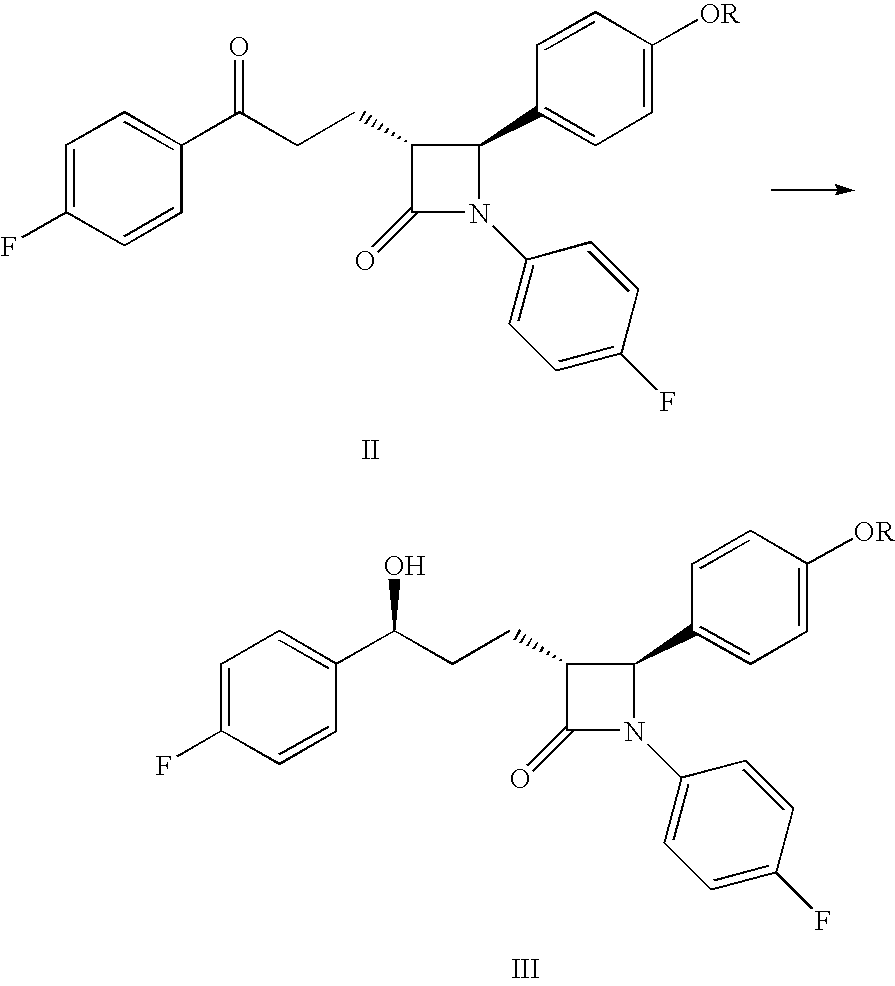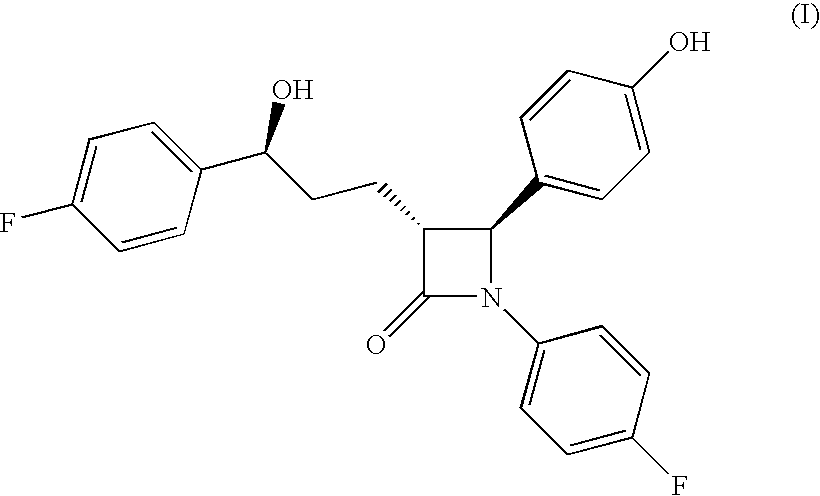Processes for preparing ezetimibe and intermediate compounds useful for the preparation thereof
- Summary
- Abstract
- Description
- Claims
- Application Information
AI Technical Summary
Problems solved by technology
Method used
Image
Examples
specific examples
[0024]The following examples are for illustrative purposes only and are not intended, nor should they be interpreted to, limit the scope of the invention.
[0025]General Experimental Conditions:
[0026]HPLC Chiral Method
[0027]The chromatographic separation was carried out in a Daicel CHIRALCEL OD-H, 5 μm, 4.6×150 mm column at room temperature (20-25° C.).
[0028]The mobile phase was prepared by mixing 950 mL of hexane with 50 mL of ethanol. The mobile phase was mixed and filtered through 0.22 μm nylon membrane under vacuum.
[0029]The chromatograph was equipped with a 232 nm detector and the flow rate was 1 mL per minute. Test samples (10 μl) were prepared by dissolving a sufficient quantity of sample in order to obtain a 0.5 mg per mL concentration in the mobile phase. Following sample injection, the chromatogram was run for at least 60 minutes.
Preparation of (3R,4S)-4-(4-(benzyloxy)phenyl)-1-(4-fluorophenyl)-3-[(3S)-3-(4-fluorophenyl)-3-hydroxypropyl]azetidin-2-one
[0030]As discussed above...
example 1
Hydrogen Transfer-type Reduction
[0031]In a 20 mL tube, 250 mg (0.5 mmol) of (3R,4S)-4-(4-(benzyloxy)phenyl)-1-(4-fluorophenyl)-3-[3-(4-fluorophenyl)-3-oxopropyl]azetidin-2-one was dissolved in 2 mL of dimethylformamide. Formic acid (0.08 mL) and triethylamine (0.31 mL) were then added to the mixture with stirring under an argon atmosphere. Next, 16 mg of chloro((S,S)—N-p-toluensulfonyl-1,2-diphenylethylendiamine)(η6-p-cymene)ruthenium (obtained from Johnson Matthey Plc) was added, and the mixture was stirred for 48 hours at 30° C. The resulting product was then added to sodium carbonate solution and extracted with dichloromethane. After drying and evaporating the solvent, the obtained product was analyzed by chiral HPLC (Conversion: 94%; d.e.=74%).
example 2
Hydrogen Transfer-type Reduction
[0032]In a 20 mL tube, 250 mg (0.5 mmol) of (3R,4S)-4-(4-(benzyloxy)phenyl)-1-(4-fluorophenyl)-3-[3-(4-fluorophenyl)-3-oxopropyl]azetidin-2-one was dissolved in 2.1 mL of a mixture of formic acid (4.4 parts) and triethylamine (2.6 parts). Next, 5.8 mg of chloro((S,S)—N-p-toluensulfonyl-1,2-diphenylethylendiamine)(η6-p-cymene)ruthenium (obtained from Johnson Matthey Plc) was added, and the mixture was stirred for 48 hours at 30° C. The product was then added to a sodium carbonate solution and extracted with dichloromethane. After drying and evaporating the solvent, the obtained product was analyzed by chiral HPLC (Conversion: 43%; d.e.=78%).
PUM
 Login to View More
Login to View More Abstract
Description
Claims
Application Information
 Login to View More
Login to View More - R&D
- Intellectual Property
- Life Sciences
- Materials
- Tech Scout
- Unparalleled Data Quality
- Higher Quality Content
- 60% Fewer Hallucinations
Browse by: Latest US Patents, China's latest patents, Technical Efficacy Thesaurus, Application Domain, Technology Topic, Popular Technical Reports.
© 2025 PatSnap. All rights reserved.Legal|Privacy policy|Modern Slavery Act Transparency Statement|Sitemap|About US| Contact US: help@patsnap.com



